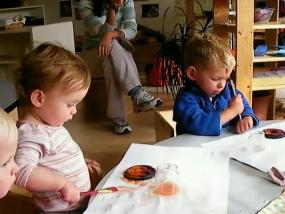The Accidental Mark

At first all we see here is a two-year old girl putting a paintbrush in water, then in the dish of paint pigments. She has no clear intention to make marks on the paper. She seems content to mull the pigments in the dish. But as may often happen, a miss of the dish yields a mark on the paper. She repeats this accident now as a deliberate voluntary action. We have witnessed in this instance a case of “incidental learning,” an important form of learning throughout the life span. Learning can happen by predicting an effect and then testing to see if you can make that particular effect happen. But learning can also happen by reading backwards from an effect that you did not predict. You, in essence, have to reinvent the action that caused the effect because the effect resulted accidentally, that is without forethought. We call it serendipity, but do not dismiss the high level thinking involved in transforming an accidental effect into a deliberate, controlled action that repeatedly yields a desired effect.
How much time do we need to give children to stay at this level of transferring color from the pigment dish to the brush to the paper? At what point do we comment on the shape of the mark or the intersection of two lines? At some point the child will move from being intrigued by the simple fact that the brush leaves a visible trail to more interest in controlling the shape of that path? Perhaps you could parallel play with the child, imitate the child’s marks, and then once the child feels your co-play, make a mark with a deliberate angle. Teachers can also add a form of co-construction to help the child learn what the medium can do and why.
Keywords: Ones, Paint
Length of video: 1 minute, 32 seconds
